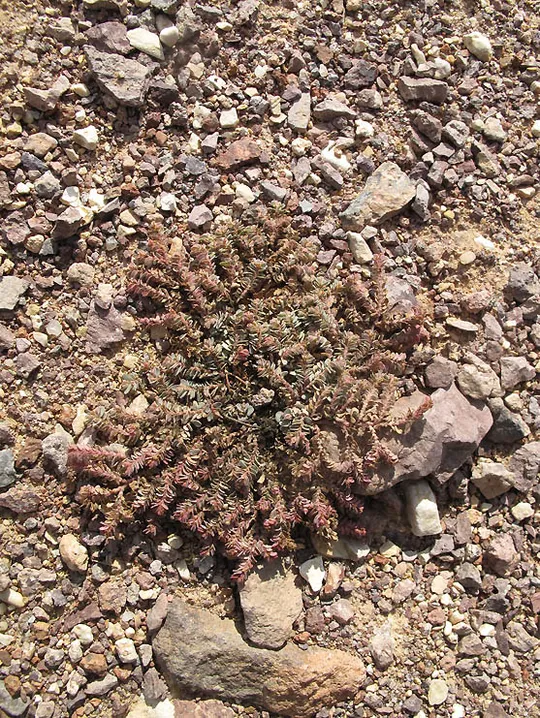Egyptian Spurge
Euphorbia forsskalii
Euphorbia forsskalii
was found in Israel only three or four times, each time on
a single site and distant from other sites: in En Gedi in the Dead Sea region
the plant was collected in 1958 and is probably now extinct. All efforts by Michael
Blecher to collect it failed. In the Arava it was collected in Wadi
Timna at an altitude of 250 meters in 1966. Since the species is Sudanian, we would expect to
be more common in this habitat, but the Arava Survey (Ron et al. 2003) as well as searches by Dudi Rivner from Elot
failed to locate E. forsskalii. The species is also
recorded, according to the Flora Palaestina and other guides, from a third
region. This record is based on a single finding in the western
Negev or in the Gaza Strip, 150 years ago, by
the scientist who first described the species. Since then E. forsskalii has not been found in the Gaza, Philistian
Plain and western Negev regions, although it is known to grow in Northern Sinai in a similar
habitat (Danin et al.1985).
Tristram noted that the botanist Dinsmore found E. forsskalii in Safi in the southern Dead Sea and in
Jericho.
In
Israeli literature, the habitat is described as "hot deserts", in reference to Euphorbia
forsskalii, which is a Sudanian species found in En Gedi and in the Arava.
In the Flora of Egypt it is indicated
as “a weed in
irrigated sandy fields". In Israel E.
forsskalii is so rare that it is
difficult to determine its characteristic habitat. There
may possibly be two ecotypes: one common in northern Sinai and in Egypt that grows as a weed in sandy fields – which is probably the one collected in the Gaza Strip 150 years ago; the second ecotype is a Sudanian species of arid
canals or field margins in extreme deserts, which would be found in
the Arava. This habitat agrees with the reports of its presence in Jericho and Safi in the 20th century.
For the genus Euphorbia – see E. phymatosperma.
E. forsskalii is systematically close to E.chamaesyce and E.granulata. It
can be easily distinguished from them by the hair covering all parts of the plant,
particularly the fruit, whose hairs are close fitting, and by the dentate margins of the
leaves at its base.
• Euphorbia forsskalii was seen or collected at
four sites, only on one of them after 1970. Consequently the plant is believed to be
extinct from the Gaza Strip (or from the western Negev), from Jericho and from the southern Arava,
and now probably grows only in the Timna Valley.
• The species is
a weed at the edge of fields throughout
Egypt, and it is not endangered at all there. In Israel has a highly fragmented and almost
random distribution pattern in the desert and is probably extinct.
A field survey should be conducted to try to locate Euphorbia
forsskalii in the western Negev and in the
Arava and its edges. Only after this
step can its habitat
be defined and plans be formulated for a central site for conserving and
managing the species.
Euphorbia forsskalii is a widely
distributed Sudanian plant: it appears throughout equatorial Africa and in South Africa, Libya, Sudan, Ethiopia, Kenya and the Horn of Africa. It also grows on the Cape Verde and the Canary islands. In the
Middle East, it is very common in Egypt and grows throughout
the country. In Arabia E. forsskalii grows only in the Asir and
Hiǧaz regions. It
is rare on sandy soil in northern Sinai and spreads northwards to Israel. The species is absent from the Sudanian
region in Iran, Pakistan and the Persian Gulf. This is a rare and distinct case of a plant whose
distribution is Sudanian but not Decanian (it
does not continue eastward to the Indian deserts).
Euphorbia forsskalii is an annual peripheral Sudanian species, very rare in Israel and possibly extinct. This is one of the few cases in which it is uncertain whether the plant species has stable populations in Israel, yet we decided to include it as red species and not
determine its status as episodic or doubtful. This is due to the
fact that there are at least three independent collections of E. forsskalii
and another two doubtful records. The samples were all collected from desert sites;
however, they were very far apart. All the finds date back forty
years and more. It is quite possible that the species is extinct, or possibly episodic.
Current Occupancy Map
| 1000 squre meter pixel | 5000 squre meter pixel | 10000 squre meter pixel | |
|---|---|---|---|
| number of observations | 0 | 0 | 0 |
| in total pixels | 0 | 0 | 0 |
| Family | Euphorbiaceae |
| Classification | On the endangered species list |
| Ecosystem | Desert |
| Chorotype | Sudanian |
| Conservation Site | Arava |
| Rarity |
1
6
6
|
|---|---|
| Vulnerability |
0
0
4
|
| Attractiveness |
0
0
4
|
| Endemism |
0
0
4
|
| Red number |
1
3.7
10
|
| Peripherality | S |
| IUCN category | DD EW EX LC CR EN VU NT |
| Threat Definition according to the red book | Vulnerable |
 Based on:
Based on:






